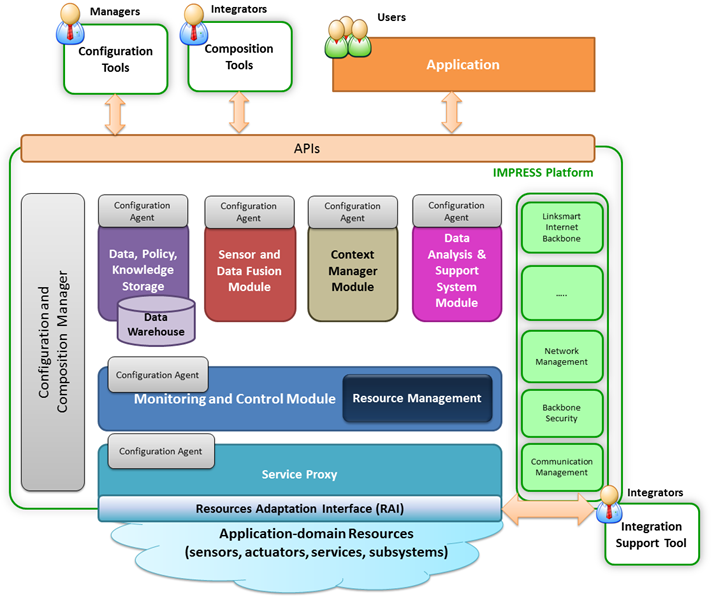The IMPReSS project will develop a Systems Development Platform (SDP) that makes it easier and more affordable to tackle the technological and human challenges of interconnected devices and usage. This is achieved by supplying a range of tools for rapid development including an Integrated Development Environment (IDE), pre-prepared software components, middleware components and a deployment tool.
The IMPReSS SDP consists of a set of technologies which help to build general-purpose applications accessing to a plethora of sources, such as information from the physical world, analysing and fusing relevant data and perform monitoring and control operations on complex system. This is achieved through the definition of a number of tools and pre-defined modules that can be managed and combined in order to define a specific logic flow. The proposed IMPReSS SDP is illustrated in the figure below:

Overview of the IMPReSS Systems Development Platform
The Application-domain Resources cloud represents all the entities that the IMPReSS platform can interoperate with, e.g. physical world devices, external and third-parties systems, and open and proprietary services.
The various resources are seamlessly connected to the IMPReSS platform through Service Proxies that expose their functionalities as Internet of Things services, irrespective of their underlying communication protocols. Service Proxies uses a Resources Adaptation Interface (RAI) that allows the IMPReSS platform to connect the Application-domain Resources and expose their measurements and capabilities through a common interface and data model.
The Monitoring and Control Module aims to optimize complex system operations acting on available Application-domain Resources exposed by the IoT Service Proxies. This module also performs Resource Management operations for solving conflicts, for scheduling and management of mixed-criticality, through the implementation of priority policies.
The Data, Policy and Knowledge Storage is responsible for managing the persistence of various data and information. Within the Data, Policy and Knowledge Storage, the Data Warehouse stores raw data from Application-domain Resources and enhanced data and information inferred by sensor and data fusion modules.
The Sensor and Data Fusion Module processes inputs from available Application-domain Resources by aggregating and filtering raw data and events and by combining data to synthesize new and enhanced application-domain information.
The Context Manager Module keeps and manages context information. It manages the context information using data extracted from available Application-domain Resources.
The Data Analysis & Support System Module identifies and extracts information. It provides support to the control algorithms performed in the Monitoring and Control Module and generates suggestions and alarms to user-side application.
The Configuration Tool sets the policies of the whole platform. It shows to the platform Manager all the devices and modules belonging to the system, allowing to configure the parameters of the modules of the overall platform.
The Composition Tool allows interconnecting the various modules belonging to the platform. This module is a commissioning tool used by the platform Integrator that allows defining the connections among the different modules needed to implement specific application logic.
The Configuration and Composition Manager is the module in charge of managing the configuration and composition processes of the other modules into the platform; it works as an interface between the Configuration and Composition Tools and the various modules within the platform.
A Configuration Agent is associated with each module of the platform. It exposes configuration and control parameters of a specific module to the Configuration and Composition Manager. The Configuration Agent operates actually the configuration commands coordinated by Configuration and Composition Manager. The association of an agent to each module makes the system more expandable and scalable from the point of view of configuration issues.
The APIs for interfacing the IMPReSS platform can be divided in three categories:
 • APIs for system Integrators: useful to support deployment and installation of the platform. They provide methods for combining different modules and commissioning the specific logic flow. • APIs for system Integrators: useful to support deployment and installation of the platform. They provide methods for combining different modules and commissioning the specific logic flow.
 • APIs for system Managers: useful to set the parameters of the platform modules to make the system effective. • APIs for system Managers: useful to set the parameters of the platform modules to make the system effective.
 • APIs for system Users: useful to operate on application level functionalities (e.g. for system monitoring and control, fine-grained configuration, etc.). • APIs for system Users: useful to operate on application level functionalities (e.g. for system monitoring and control, fine-grained configuration, etc.).
The IMPReSS platform builds on the LinkSmart Middleware formerly defined within the Hydra project and that is being used and extended in other EU projects ([SEEMPubS] (FP7), [ME3Gas] (ARTEMIS) and ebbits (FP7) projects). The LinkSmart middleware provides interoperable interconnection among appliances, devices, terminals, subsystems, services and predefined modules. LinkSmart enables a Service Oriented Architecture (SoA) and facilitates interoperability between devices and other web services. The green blocks in the figure represent the core of the LinkSmart Middleware. These modules are responsible for the connection of the platform to the Internet Backbone, for the communication and security management (e.g. access control), network administration, etc.
|




